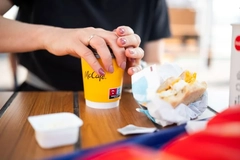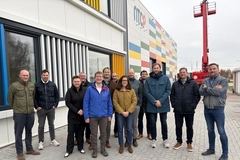Rigid plastic recycling: Packaging industry navigates regulation and contamination challenges

Separate collection infrastructure in the public space will be key to getting used items into the recycling stream and boosting rigid plastic circularity, according to Eamonn Bates, secretary general at 360° Foodservice, the EU association for the foodservice packaging value chain based in Brussels, Belgium.
However, Bates warns that material-specific collections will be difficult to achieve with “the levels of ambivalence we see today from most governments.”
Meanwhile, Santeri Marjamäki, ecosystem manager at UPM Raflatac, tells us that a key challenge in improving rigid plastic circularity lies in material stream contamination, impacting the quality and usability of recyclates.
Packaging Insights sits down with Bates and Marjamäki to learn more about the current demand for rigid plastic packaging, the shift from single-use to reusable solutions, and the associated recycling challenges.
Bates tells us that a common focus from all stakeholders on finding “joined up” solutions is indispensable if the complex challenges of achieving greater circularity in practice are to be overcome.
“This common focus has got to involve governments taking their share in the investments that are needed and creating the right conditions to make collection and recycling work.”
Better consumer participation in recycling practices is critical, says Bates.“For example, we need a better separate collection of used plastics packaging to deliver more and better-quality input to the recyclers to enable them to produce high-quality recyclate at more affordable prices.”
Bates says that better participation in separate collection practices by consumers is also critical. “This, in turn, depends on the availability of convenient, accessible, and effective collection systems and infrastructure that work for them.”
“After that, we need enhanced sorting facilities and processes, as well as more and better recycling options. There is lots of scope for technology and system innovation.”
Clean separation challenges
One of the key challenges in improving rigid plastic circularity derives from contamination within material streams, which can significantly impact the quality and usability of recyclates, Marjamäki tells us.
“At UPM Raflatac, we’re addressing this directly by developing label solutions that are compatible with recycling processes and help reduce contamination at the source.”
“Our New Wave label material has been tested to perform without fiber loss during recycling, helping ensure that the resulting recyclate remains high-quality and suitable for reuse in new packaging applications. This not only preserves material integrity but also provides packaging producers with greater flexibility to use label materials derived from renewable sources.”
Marjamäki says that it is essential to address label removability and consider both the label adhesive and face material to enhance recyclability in bottle-to-bottle recycling processes for HDPE and PP rigid packaging.
“By developing compatible label and adhesive combinations that enable clean separation during the recycling process, we’re helping to support a closed-loop system where plastic packaging can be more effectively recovered and reused, rather than downcycled or lost to landfill,” he explains.
Rigid plastic for food packaging
In some parts of the market, there is an ongoing trend toward replacing single-use plastics with fiber-based alternatives, but these can be a more costly option, according to Bates.  UPM’s New Wave paper label material for rigid HDPE and PP containers (Image credit: UPM).
UPM’s New Wave paper label material for rigid HDPE and PP containers (Image credit: UPM).
“There is still good demand for single-use foodservice plastics packaging, so long as the local legislators do not impose other obligations.”
UPM sees the strongest demand for rigid plastic solutions from customers within the HPC and food categories. “These markets continue to prioritize packaging that combines strong shelf appeal with improved sustainability credentials — especially in terms of recyclability and the use of renewable or recycled materials.”
“Our Packaging Recyclability Guide has proven extremely valuable for customers and brands in these categories by helping them navigate the complexities of packaging design and recyclability.”
“As regulations tighten and consumer expectations rise, demand is growing for label materials that support closed-loop recycling and reduce environmental impact, without compromising on performance or appearance.”
Reusable rigid containers
The EU’s Single-Use Plastics Directive requires EU member governments to achieve “ambitious and sustained” market consumption reduction measures for plastic-based foodservice packaging in their national markets.
But Bates says that most national governments have not yet started this legislative transformation. “Once they do, expect to see more in-country single-use foodservice packaging bans and reuse targets.”
“Paper products with plastic elements — like coffee cups — will not escape the market consumption restrictions because the EU single-use law treats packs with even tiny elements of plastics in the same way as 100% plastic containers, they are all ‘plastics’ according to the law.”
“Interestingly, the single-use law takes precedence over the more recent packaging and packaging waste regulation that allows fiber/plastics composite packaging for in-store use.”
 UPM says it develops labels that are compatible with recycling processes and help reduce contamination.“Despite that, member states will be entirely within their rights to impose reuse systems for in-store consumption to obtain those ambitious and sustained market consumption reductions. Some governments will go down this road opening opportunities for reusable rigid plastics systems.”
UPM says it develops labels that are compatible with recycling processes and help reduce contamination.“Despite that, member states will be entirely within their rights to impose reuse systems for in-store consumption to obtain those ambitious and sustained market consumption reductions. Some governments will go down this road opening opportunities for reusable rigid plastics systems.”
Is plastic vs. paper the real debate?
Meanwhile, UPM has taken note of the general trend of brands opting for fiber-based packaging. Marjamäki says that this shift is only expected to accelerate in applications where the contents of the package allow the switch of the packaging format.
“When it comes to self-adhesive labels requirements, the recycling process of fiber-based packaging, particularly in specialized mills, is designed to handle contaminations, removing non-paper components through multiple screening and cleaning stages,” he says.
Marjamäki explains that the process typically screens out plastic labels and adhesives. “Standard paper labels on cardboard boxes can be recycled using current methods, and the fibers from these labels often increase the yield of the recycled material.”
“At UPM Raflatac, we offer label solutions that are recycling compatible with fiber-based packaging. These include paper labels with recycling compatible adhesives that have been assessed as recyclable in the paper and board-based packaging stream by the fiber-based research and development institute, Institut für Fasern & Papier, Germany.”
“It is the application specific requirements which determine the compatible packaging and label materials. Whatever packaging material brands end up choosing — whether that be plastic, fiber-based, glass, or aluminium — we offer label solutions which support the recyclability of that packaging.”
Meanwhile, Bates says it is no secret that many CPGs have been moving away from plastic due to “anti-plastics sentiments.” As a result, some packaging providers have also stepped away from plastics. On the other hand, Bates says there are others that have picked up these “abandoned” markets and are doing well.
“The paper-versus-plastics debate in the packaging field is sterile — there is a place for both materials, but the key point is that all packaging systems, regardless of materials used, need to be circular.”
“The truth is, in many applications today, neither fiber nor plastics are truly circular. That is certainly true of foodservice packaging.”
A lot of companies are looking beyond single-use plastics toward reusable products but there are plenty of technical obstacles to overcome.
“Many also see that the infrastructures to make a success of reuse systems are lacking. It is not clear when a ‘tipping point’ will come when companies can see a route to a more viable business model in the future in the reuse segment. So, game-changing investment is not really happening,” Bates concludes.











